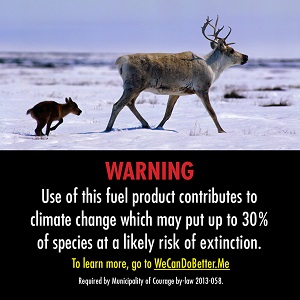What can a simple sticker possibly do to counter the systemic and intricate causes of climate change? The answer appears to be “lots!” for the right sticker at the right place.
 As part of the Osgoode Environmental Justice and Sustainability Clinic, I have had the honour of working with the non-profit organization Our Horizon this year. Our Horizon’s aim is straight forward: we work with municipalities across Canada to put laws or policies in place requiring climate change warning labels to be displayed on gas pump nozzles. However, the simplicity of this idea can be deceptive and it is easy to miss how well it addresses several fundamental problems specific to climate change.
As part of the Osgoode Environmental Justice and Sustainability Clinic, I have had the honour of working with the non-profit organization Our Horizon this year. Our Horizon’s aim is straight forward: we work with municipalities across Canada to put laws or policies in place requiring climate change warning labels to be displayed on gas pump nozzles. However, the simplicity of this idea can be deceptive and it is easy to miss how well it addresses several fundamental problems specific to climate change.
One problem in the way of addressing climate change is the current moment bias. Simply put, current moment bias means that people are unable to accurately weigh the consequences of an action if these consequences are going to happen at a future time. This phenomenon is likely a significant contributor to environmental inaction in Canada. Warning labels circumvent this problem by building feedback in the form of explicit reminders of the consequences of petroleum consumption at the moment of consumption.
A second problem addressed by the warning labels is the diffusion of responsibility. The vast majority of the global population contribute to climate change to some extent. Consequently, it is very easy for individuals to pass on the responsibility to a faceless collective against which their actions are absolutely meaningless. Unfortunately, this notion is as flawed as it is comforting, and collective responsibility is a poor rewording for the sum of individual responsibilities. Warning labels help us remember our individual responsibilities by placing a reminder of our individual contributions in the palms of our hands.

Rob Shirkey (Our Horizon) and Gun Koleoglu JD '16
Climate change warning labels also provide a solution to the problem of communicating externalities. The price of gas does not reflect the environmental cost of consuming gas. More importantly, quantitative externality deterrents, such as externality taxes, are only effective at very high rates. As a result, it is difficult, if not impossible, to communicate the true cost of gas externalities through quantitative deterrents. Warning labels side-step this problem by representing the true cost of gas in a qualitative manner through images and text.
More broadly, the strength of the warning labels lies in their disruptive potential. Transportation is the second largest source of greenhouse gas emissions and its impact has been growing over the past decades. The emissions resulting from combustion vastly overshadow the collective emissions of all the operations it takes for gas to get from the ground to the gas tank. Despite this, pumping gas is almost an automated act for most drivers. We do not think about it; it’s a passive aspect of driving. Warning labels disrupt this status quo by creating marginal discontent in the consumer. In this sense, warning labels can act as catalysts for change by fostering dissatisfaction and creating demand for stronger environmental protection and more environmentally conscious products.
Finally and most importantly, Our Horizon’s initiative empowers municipalities to take charge in what has so far been a federal and provincial enterprise. Ontario legislators have recognized (if you follow the link, scroll down to “Municipal Legislation”) that the challenges of the 21st century require municipalities to have broad authority over multiple areas of jurisdiction. Similarly, the Supreme Court of Canada has emphasized that environmental and other issues should be addressed by the level of government “closest to the citizens affected and thus most responsive to their needs, to local distinctiveness, and to population diversity”.
Municipalities have the legal authority and jurisdiction to mandate climate change warning labels on gas pumps. Unfortunately, many municipal officials are reluctant to exercise their power in new ways despite the legislative and judicial support. The widespread adoption of the warning labels would be a strong precedent for municipalities adopting climate change measures according to their particular circumstances.
Ending an environmentally-oriented blog post on a positive note is a rare pleasure and I am very happy to write about how well our campaign has progressed. The warning labels have received endorsements from over 100 academics from broad disciplines ranging from finance to natural sciences. Similarly, multiple non-profit organizations including the David Suzuki Foundation and the Canadian Association of Physicians for the Environment have endorsed the idea. On the municipal side, West Vancouver was the first city to pass a resolution in support of warning labels. West Vancouver’s resolution was followed by several British Columbia municipalities before the momentum culminated with the adoption of a resolution in favor by the Union of British Columbia Municipalities last September. The following month the Francophone Municipalities of New Brunswick adopted a resolution in favor of the warning labels. In Ontario, several municipalities including Waterloo have already adopted the idea and several others are currently considering it. Most importantly, North Vancouver became the first municipality to go beyond a resolution and adopt a by-law implementing the labels in 2015.
Climate change risk disclosure on gas pump nozzles might just be next big Canadian idea that will change the world.

